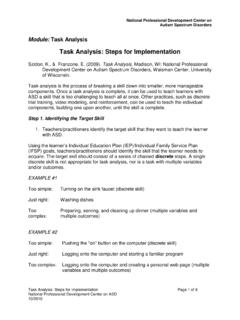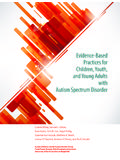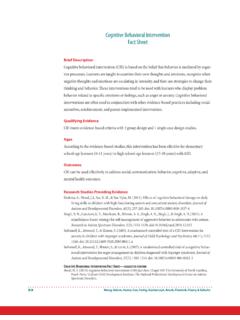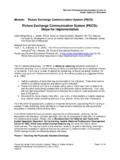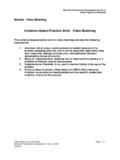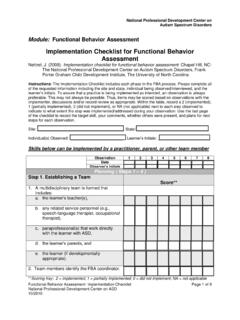Transcription of Evidence-Based Practice Brief: Visual Supports - Autism PDC
1 National Professional Development Center on Autism Spectrum Disorders Module: Visual Supports Evidence-Based Practice Brief: Visual Supports This Evidence-Based Practice brief on Visual Supports includes the following components: 1. Overview, which gives a quick summary of salient features of the Practice , including what it is, who it can be used with, what skills it has been used with, settings for instruction, and additional literature documenting its use in Practice 2. Steps for Implementation, detailing how to implement the Practice in a practitioner-friendly, step-by-step process 3. Implementation Checklist, to be used to monitor fidelity of the use of the Practice 4. Evidence Base Summary, which details the NPDC-ASD criteria for inclusion as an Evidence-Based Practice and the specific studies that meet the criteria for this Practice Visual Supports : Cover Sheet Page 1 of 1. National Professional Development Center on ASD. 10/2010. National Professional Development Center on Autism Spectrum Disorders Module: Visual Supports Overview of Visual Supports Hume, K.
2 (2008). Overview of Visual Supports . Chapel Hill, NC: National Professional Development Center on Autism Spectrum Disorders, Frank Porter Graham Child Development Institute, The University of North Carolina. Visual Supports are any tool presented visually that Supports an individual as he or she moves through the day. Visual Supports might include, but are not limited to, pictures, written words, objects within the environment, arrangement of the environment or Visual boundaries, schedules, maps, labels, organization systems, timelines, and scripts. They are used across settings to support individuals with ASD (National Research Council, 2001). Evidence Visual Supports meet the Evidence-Based Practice criteria within the early childhood, elementary, and middle school age groups. With what ages are Visual Supports effective? Visual Supports can be implemented with individuals across the age range, beginning in preschool and extending through middle school age. Effective Visual Supports in early childhood settings include Visual schedules to increase task engagement, Visual scripts to encourage social interaction, and picture cues to support play skill development (Krantz & McClannahan, 1998; Massey & Wheeler, 2000; Morrison, Sainato, BenChaaban, & Endo, 2002).
3 In elementary and middle school, Visual Supports such as schedules and picture cues have proven effective in reducing transition time, increasing on-task behavior, and in completing self-help in the home (Bryan & Gast, 2000; Dettmer, Simpson, Myles, & Ganz, 2000; MacDuff, Krantz, &. McClannahan, 1993). What skills or intervention goals can be addressed by Visual Supports ? Visual Supports target a number of adaptive behavior skills, including task engagement, independent performance, transitions across activities, and increasing response chain length. Visual Supports have also proven effective in increasing skills across curriculum areas, including the demonstration of play skills, social interaction skills, and social initiation. In addition, Visual Supports have been beneficial in reducing self-injurious behavior. In what settings can Visual Supports be effectively used? Visual Supports have been used effectively in classroom settings and home settings. Visual Supports are intended to be used as one component of comprehensive programming for individuals with ASD.
4 Visual Supports : Overview Page 1 of 3. National Professional Development Center on ASD. 10/2010. National Professional Development Center on Autism Spectrum Disorders Module: Visual Supports Evidence Base The studies cited in this section provide the basis upon which this Practice was determined to meet the NPDC on ASD's criteria as an Evidence-Based Practice . This list is not exhaustive and other quality studies may exist but were not found in our search. Preschool Dauphin, M., Kinney, E. M., & Stromer, R. (2004). Using video enhanced activity schedules and matrix training to teach sociodramatic play to a child with Autism . Journal of Positive Behavior Interventions, 6, 238 250. Johnston, S., Nelson, C., Evans, J., & Palazolo, K. (2003). The use of Visual Supports in teaching young children with Autism spectrum disorder to initiate interactions. AAC: Augmentative & Alternative Communication, 19, 86-104. Krantz, P. J., & McClannahan, L. E. (1998). Social interaction skills for children with Autism : A.
5 Script-fading procedure for beginning readers. Journal of Applied Behavior Analysis, 31, 191-202. Massey, G., & Wheeler, J. (2000). Acquisition and generalization of activity schedules and their effects on task engagement in a young child with Autism in an inclusive preschool classroom. Education and Training in Mental Retardation and Developmental Disabilities, 35, 326-335. Morrison, R., Sainato, D., BenChaaban, D., & Endo, S. (2002). Increasing play skills of children with Autism using activity schedules and correspondence training. Journal of Early Intervention, 25, 58-72. Elementary and Middle School Age Bryan, L., & Gast, D. (2000). Teaching on-task and on-schedule behaviors to high functioning children with Autism via picture activity schedules. Journal of Autism and Developmental Disorders, 30, 553-567. Dettmer, S., Simpson, R., Myles, B., & Ganz, J. (2000). The use of Visual Supports to facilitate transitions of students with Autism . Focus on Autism and Other Developmental Disabilities, 15, 163-170.
6 Krantz, P., MacDuff, M., & McClannahan, L. (1993). Programming participation in family activities for children with Autism : Parent's use photographic activity schedules. Journal of Applied Behavior Analysis, 26, 137-138. MacDuff, G., Krantz, P., & McClannahan, L. (1993). Teaching children with Autism to use photographic activity schedules: Maintenance and generalization of complex response chains. Journal of Applied Behavior Analysis, 26, 89-97. O'Reilly, M., Sigafoos, J., Lancioni, G., Edrisinha, C., & Andrews, A. (2005). An Visual Supports : Overview Page 2 of 3. National Professional Development Center on ASD. 10/2010. National Professional Development Center on Autism Spectrum Disorders Module: Visual Supports examination of the effects of a classroom activity schedule on levels of self-injury and engagement for a child with severe Autism . Journal of Autism & Developmental Disorders, 35, 305-311. Pierce, K., & Schreibman, L. (1994). Teaching daily living skills to children with Autism in unsupervised settings through pictorial self-management.
7 Journal of Applied Behavior Analysis, 27, 471-481. Schmit, J., Alper, S., Raschke, D., & Ryndak, D. (2000). Effects of using a photographic cueing package during routine school transitions with a child who has Autism . Mental Retardation, 38, 131 137. Vaughn, B., & Horner, H. (1995). Effects of concrete versus verbal choice systems on problem behavior. Augmentative and Alternative Communication, 11, 89-92. Selected Additional References Cohen, M. J., & Sloan, D. L. (2007). Visual Supports for people with Autism : A guide for parents and professionals. Bethesda, MD: Woodbine House. Mesibov, G., Shea, V., & Schopler, E. (2005). The TEACCH approach to Autism spectrum disorders. New York: Plenum Press. National Research Council (2001). Educating children with Autism . Washington, DC: National Academy Press. Quill, K. A. (1997). Instructional considerations for young children with Autism : The rationale for visually cued instruction. Journal of Autism and Other Developmental Disorders, 27(6), 697-714.
8 Tissot, C., & Evans, R. (2003). Visual teaching strategies for children with Autism . Early Child Development and Care, 174(4), 425-433. Visual Supports : Overview Page 3 of 3. National Professional Development Center on ASD. 10/2010. National Professional Development Center on Autism Spectrum Disorders Module: Visual Supports Evidence Base for Visual Supports The National Professional Development Center on ASD has adopted the following definition of Evidence-Based practices. To be considered an Evidence-Based Practice for individuals with ASD, efficacy must be established through peer-reviewed research in scientific journals using: randomized or quasi-experimental design studies. Two high quality experimental or quasi-experimental group design studies, single-subject design studies. Three different investigators or research groups must have conducted five high quality single subject design studies, or combination of evidence. One high quality randomized or quasi-experimental group design study and three high quality single subject design studies conducted by at least three different investigators or research groups (across the group and single subject design studies).
9 High quality randomized or quasi experimental design studies do not have critical design flaws that create confounds to the studies, and design features allow readers/consumers to rule out competing hypotheses for study findings. High quality in single subject design studies is reflected by a) the absence of critical design flaws that create confounds and b) the demonstration of experimental control at least three times in each study. Horner, R., Carr, E., Halle, J., McGee, G., Odom, S., & Wolery, M. (2005). The use of single subject research to identify Evidence-Based Practice in special education. Exceptional Children, 71, 165-180. Nathan, P., & Gorman, J. M. (2002). A guide to treatments that work. NY: Oxford University Press. Odom, S. L., Brantlinger, E., Gersten, R., Horner, R. D., Thompson, B., & Harris, K. (2004). Quality indicators for research in special education and guidelines for Evidence-Based practices: Executive summary. Arlington, VA: Council for Exceptional Children Division for Research.
10 Rogers, S. J., & Vismara, L. A. (2008). Evidence based comprehensive treatments for early Autism . Journal of Clinical Child and Adolescent Psychology, 37(1), 8-38. Visual Supports : Evidence Base Page 1 of 3. National Professional Development Center on ASD. 10/2010. National Professional Development Center on Autism Spectrum Disorders Module: Visual Supports Using these criteria, the empirical studies referenced below provide documentation for supporting peer mediated instruction and intervention as an Evidence-Based Practice . This list is not exhaustive; other quality studies may exist that were not included. Preschool Dauphin, M., Kinney, E. M., & Stromer, R. (2004). Using video enhanced activity schedules and matrix training to teach sociodramatic play to a child with Autism . Journal of Positive Behavior Interventions, 6, 238 250. Johnston, S., Nelson, C., Evans, J., & Palazolo, K. (2003). The use of Visual Supports in teaching young children with Autism spectrum disorder to initiate interactions.
